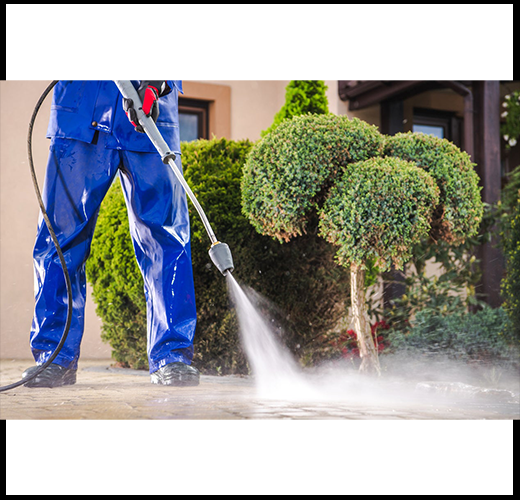How a Pressure Washer Operates
How a Pressure Washer Operates
Table of Contents
Introduction
There are times in industrial laundry, you have tried clean water, have applied detergent, have introduced washing chemicals and the dirt poses to be stubborn. Then it is time to roll out the pressure washer. Pressure washers can be used for a variety of outside tasks such as cleaning backyard patios, decks, driveways, washing down patio furniture, vehicles, siding or preparing surfaces for painting.
A pressure washer or power washer is a high-pressure mechanical sprayer used to remove loose paint, mold, grime, dust, mud, and dirt from surfaces and objects such as buildings, vehicles and concrete surfaces. The volume of a pressure washer is expressed in gallons or liters per minute, often designed into the pump and not variable. The pressure, expressed in pounds per square inch, pascals, or bar (deprecated but in common usage), is designed into the pump but can be varied by adjusting the unloader valve. Machines that produce pressures from 750 to 30,000 psi (5 to 200 MPa) or more are available.
It is important that the water supply be adequate for the pressure washer connected to it, as water starvation will lead to cavitation and damage to the pump elements. Be sure your water source can provide the gallons per minute the pump requires.
The basic pressure washer consists of a motor (either electric, internal combustion, pneumatic or hydraulic) that drives a high-pressure water pump, a high-pressure hose and a trigger gun-style switch. Just as a garden hose nozzle is used to increase the velocity of water, a pressure washer nozzle creates high pressure and velocity.
Different types of nozzle are available for different applications. Some nozzles create a water jet that is in a triangular plane (fan pattern), others emit a thin jet of water that spirals around rapidly (cone pattern). Nozzles that deliver a higher flow rate lower the output pressure. Most nozzles attach directly to the trigger gun.
Parts (Components) of Pressure washer
Different Types of Pressure Washers
1. Cold Water Pressure Washers:
Cold-water pressure washers are the most commonly used type of pressure washer. This is due to the fact that they are more affordable to produce and easier to use overall. When you purchase one of these cold-water pressure washers, you can expect that it will work perfectly for pressure washing service and can do anything that you need to do at your home.
2. Hot Water Pressure Washers:
Hot-water pressure washers can reach temperatures of up to 311 degrees Fahrenheit. You can clean things much more easily when you have access to water that is this hot. When you have access to using really hot water, it is going to be much easier to clean things that are caked with oil and grease. You won’t have to worry about not being able to clean these items effectively because the hot water pressure washer is going to cut right through that grime. You won’t even need to use as much detergent when the water is this hot so it can be very convenient to use.
How to Wash Away Oil Stains with a Pressure Washer
Oil from an old or leaking car can leave big nasty stains on your surfaces that are an eyesore and a slipping hazard. You should take care of these dirty spots right away before they set in on your surfaces. Fortunately, the task isn’t too difficult. With the right materials and tools, you can clean this mess up in no time.
Step 1: Clear the surfaces of any obstructions. This might include any cars, storage items, and even your kid’s toys. Then do a quick sweep of your surfaces using a large utility broom, removing any debris such as small stones, twigs, leaves and dirt.
Step 2: Soak up the oil stains with an ample amount of detergent. Start by pouring and spreading an even amount on top of the excess oil. Give it about 20-30 minutes for the stains to be absorbed. For bigger oil puddles let the absorbent material sit overnight.
Step 3: As hard as surfaces might appear to be, it is still porous. That means it’s still possible for oil to seep into some of its small holes. This will definitely show when oil stains are given time to dry and set. So, you should definitely try to clean any oil spills when you first spot them.
Step 4: Set up your pressure washer. A hot water pressure washer will work better in this situation, simply because hot water has a way of breaking down oil and grease on a molecular level. Think about how much easier it is to wash oily and dirty dishes with hot water than with cold. A regular cold water pressure washer will also work. Make all the connections, which will involve attaching a garden hose to the washer, a pressure washer wand to the pressure hose, and a pressure washer nozzle to the wand. Prepare a cleaning detergent. There are ones that are specifically used in pressure washers. Some pressure washers have a detergent tank that you can pour the detergent into. Others will require a siphon hose to carry the detergent from an external source into the washer unit.
Step 5: Spray down the surfaces using sweeping strokes. Hold the wand about 12 inches away from the surfaces. Make sure to cover all the surfaces with a layer of detergent. For easier execution, work in small sections going back and forth and overlapping each stroke by a couple of inches. Allow the detergent to soak into the surfaces for a couple minutes so that it can do its job of loosening up the oil, dirt and grime that has gotten into the surface pores. Be sure not to let the detergent dry out.
Step 6: After the nozzle switch has been made, rinse out the detergent from the surfaces with the same pattern you used when you first sprayed detergent on. When you get to the oil spots, spend a little bit more time sweeping the area so that the pressure can lift and wash away the detergent filled oil from the surface pores. You could also bring the wand closer to the surface for the same effect.
How Pressure Washer Works
Pressure washers are part garden hose and part air compressor. A typical pressure washer has either a gas-fueled engine or electrical powered motor that powers a water pump. The pump accelerates the water, supplied from a garden hose, to produce high pressure. The washer is hooked to a high pressure-rated hose. At the end of the hose is a water gun that looks similar to the pressure guns used at car washes. When the trigger is pulled, the water mixes with the air and comes out of the nozzle.
Pressure washers can aggressively blast things clean with water jets pressurized at about 75 times the pressure of a garden hose. Or, they can gently spray with lower pressures for delicate cleaning. Pressure washers are commonly rated by Pounds per Square Inch (PSI) which gives power to penetrate the dirt and grime. and Gallons per Minute (GPM) which gives you the power to break down dirt and wash it away.
When choosing the best pressure washer for your needs, there are two general cleaning terms to understand. Overall cleaning performance is determined by how these work together. The higher the numbers, the faster you can clean.
Quick summary of the basic mechanism :
- Detergent flows in from a bottle or container through one hose.
- Cold water flows in from a faucet (tap) through another hose and is filtered on the way in.
- An electric motor or diesel engine powers the washer.
- Powered by the engine or motor, a water pump (impeller) draws in the detergent and water and mixes them together. Most washers also heat the water to a temperature of 50–70°C .
- The pump squirts out the hot, soapy water through the reinforced, high-pressure exit hose (and whatever attachment is fixed onto it). The narrow nozzle on these attachments helps to increase the pressure of the water jet even more. The high-pressure of the jet not only cleans more effectively but means you are wasting around 80 percent less water than if you used an ordinary low-pressure hosepipe (which is more economical if your water is metered)
Frequently Asked Question (FAQs)
How does a pressure washer trigger work?
Answer
The trigger gun pushes out the water from the trigger when the unloader allows the water. The water is sent to the gun and the one who is operating the pressure washer would depress the trigger to allow the spraying water.
Conclusion
The pressure washer is really a very efficient and useful tool. It saves a lot of time, labor and water. It is used industrially to hasten up work.














